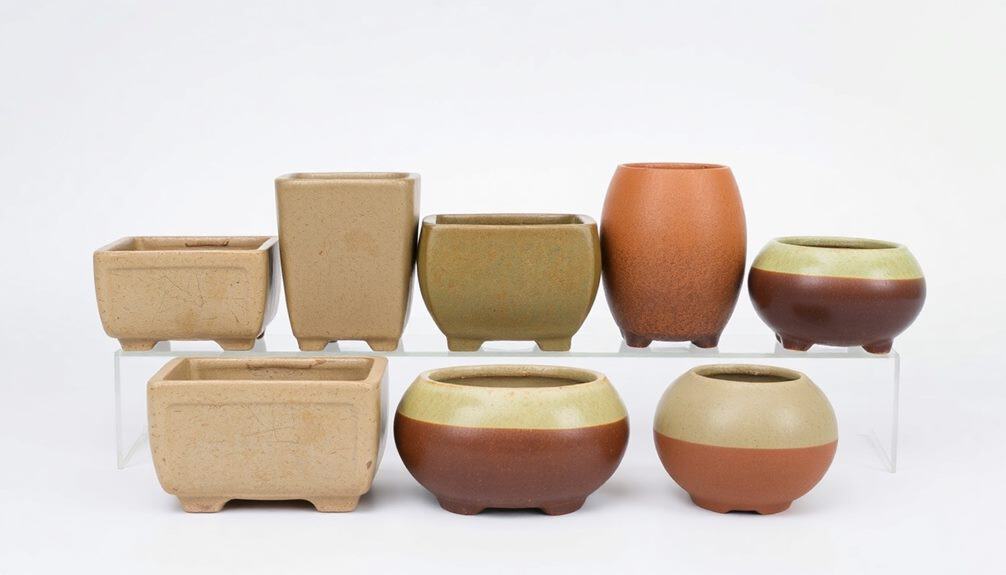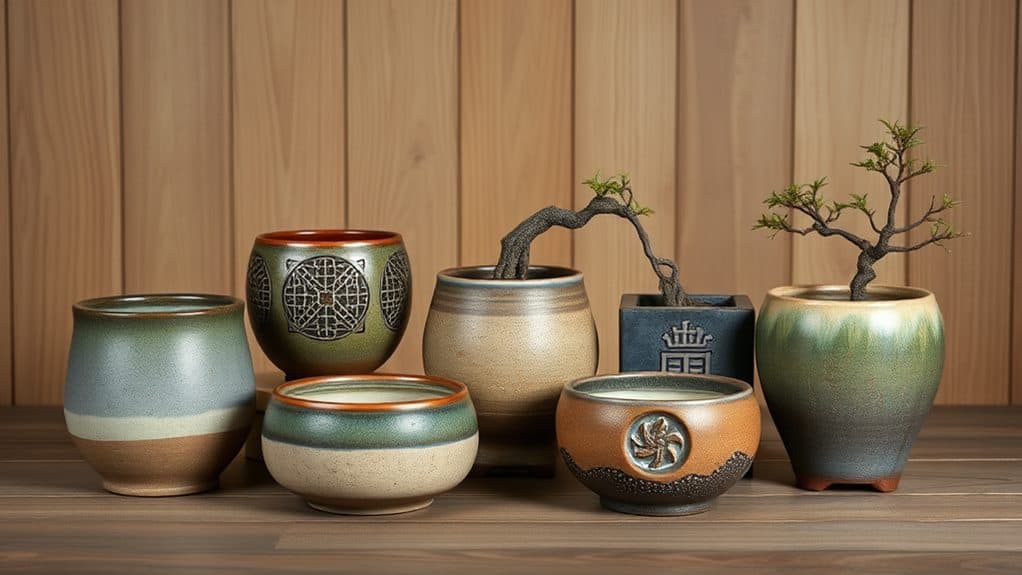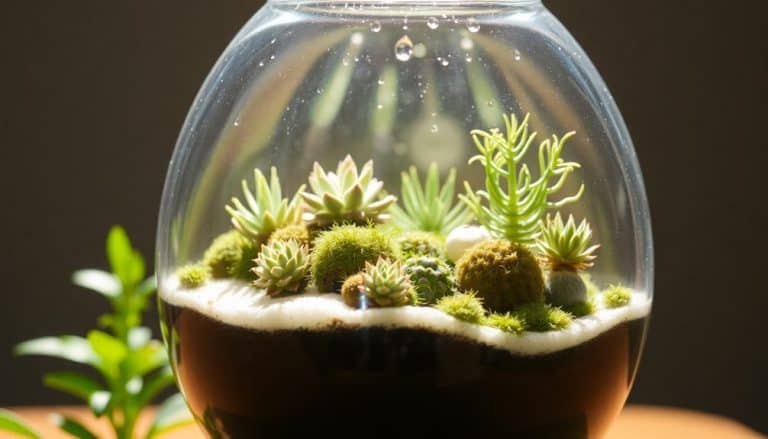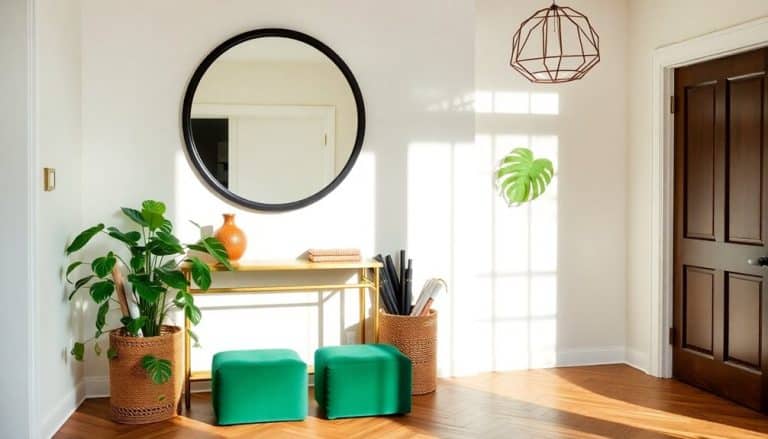This website contains affiliate links. Some products are gifted by the brand to test. As an Amazon Associate, I earn from qualifying purchases. The content on this website was created with the help of AI.
For the best bonsai pots in 2024, you’ll want to take into account Harris Bonsai Soil’s premium blend for ideal growth conditions and MUZHI’s handcrafted ceramic planter with its breathable Zisha clay construction. GROWNEER’s 6-pack training pots offer great value with smart drainage features, while Bonsai Outlet’s shatter-proof poly-resin pots provide durability and stability. The 8 Pack Training Pots round out the top choices with their versatile design and weather-resistant properties. Whether you’re a beginner or seasoned enthusiast, these expert-recommended options balance essential functionality with aesthetic appeal – but there’s more to choosing the perfect pot than meets the eye.
Key Takeaways
- MUZHI Ceramic Bonsai Planter leads 2024’s selections with premium Zisha clay construction, five drainage holes, and superior breathability for root health.
- GROWNEER’s 6-pack Training Pots offer exceptional value with smart drainage design and complete starter accessories for beginners.
- Bonsai Outlet Training Pots feature shatter-proof poly-resin construction and built-in drainage mesh, ideal for long-term bonsai development.
- The 8 Pack Bonsai Training Pots provide versatile sizing at 9×6.6×3 inches, perfect for various tree species and growth stages.
- MUZHI’s handmade design ensures uniqueness, while included tools and dense foam packaging demonstrate superior craftsmanship and delivery protection.
Harris Bonsai Soil, All Purpose Premium Blend for Outstanding Growth, 2qt
- Premium Blend - An excellent blend of forest humus, pumice, calcined clay, organic amendments, basalt rock dust and lime
- All Purpose - For all different species of bonsai including Juniper, Pine, Fiscus, Fir and many more
- Improves Drainage - Ensures that excess moisture drains efficiently while retaining just enough for the plant to thrive
For both novice and experienced bonsai enthusiasts seeking premium soil composition, the Harris Bonsai All Purpose Premium Blend delivers a perfectly balanced mix of forest humus, pumice, calcined clay, and essential amendments.
You’ll find this 2-quart blend particularly effective for various bonsai species, including Juniper, Pine, Ficus, and Fir. The addition of basalt rock dust and lime sets this mix apart, providing vital nutrients while ensuring ideal drainage. Users consistently report minimal transplant stress and impressive new growth after repotting.
What makes this soil stand out is its versatility – you can use it for a single bonsai container or divide it among several smaller pots. While some users wish for smaller packaging options, they overwhelmingly praise the soil’s quality and its time-saving convenience compared to creating custom mixes from scratch.
Best For: Bonsai enthusiasts of all skill levels looking for a premium, pre-mixed soil blend that promotes healthy growth across multiple bonsai species.
Pros:
- Excellent drainage properties while maintaining proper moisture retention for optimal plant health
- Comprehensive blend includes vital nutrients like basalt rock dust and lime, eliminating need for additional amendments
- Versatile mix suitable for multiple bonsai species and can be used in various container sizes
Cons:
- Only available in 2-quart size, which may be too much for hobbyists with single small plants
- Premium pricing compared to basic soil options
- May require additional purchases for larger bonsai collections due to package size
MUZHI Ceramic Bonsai Planter Pot with Tray (8.5 Inch)
- 1 PACKAGE INCLUDED: 1PC Planter 8.5*6.7inch (L*W); 1PC Saucer 8.4*6.2inch ,1set Garden Tool,1 Mesh Pad.
- 2 MATERIAL: Quality Zisha Clay , high streghth and small particles. No glazed make plant breath well.
- 3. ELEGANT: This Zisha Pot combined with Rectangular Sturdy PP Melamine Saucer ,It’s perfect shaped for your plant growth , A rustic style makes...
Seasoned bonsai enthusiasts will appreciate the MUZHI Ceramic Bonsai Planter‘s thoughtful design, which combines traditional craftsmanship with practical functionality. Made from quality Zisha clay, this unglazed 8.5-inch pot features five drainage holes and four wiring holes, making it ideal for both training and displaying your bonsai.
You’ll find the pot’s porous terracotta construction helps prevent root rot by allowing faster soil drying, while four raised feet enhance airflow. The elegant rustic style and color gradation add visual appeal, and the handmade nature guarantees each piece is unique, complete with the creator’s signature. While the included plastic tray isn’t as premium as the pot itself, you’ll get excellent value with the bonus garden tool set and mesh pad. The heavyweight construction provides stability, and dense foam packaging guarantees safe delivery.
Best For: Bonsai enthusiasts and plant collectors seeking a traditional, well-crafted planter with proper drainage and training features for their small trees and plants.
Pros:
- High-quality Zisha clay construction with excellent drainage and breathability
- Thoughtful design with multiple drainage holes, wiring holes, and raised feet
- Includes useful accessories like garden tools and mesh pad
Cons:
- Plastic tray appears less premium compared to the ceramic pot
- Handmade nature means size and color variations may occur
- May be heavier than similar-sized plastic or composite planters
GROWNEER Bonsai Training Pots with Drainage (6 Pack)
- Premium Plastic Construction: Made from durable, eco-friendly plastic for long-lasting use.
- Convenient Size: Compact 6.5 inch pot and tray combo is ideal for small plants and bonsai trees.
- Raised Mesh Design: Built-in holes and raised feet promote proper airflow and drainage.
Bonsai enthusiasts seeking an affordable starter set will find exceptional value in the GROWNEER 6-Pack Training Pots. These 6.5-inch plastic containers feature a smart design with multiple drainage holes, raised mesh bottoms, and built-in feet that promote ideal airflow and water management for your plants.
You’ll appreciate the practical features that come with this set. Each purchase includes a repotting mat, 15 plant labels, and humidity trays, making it a complete solution for both beginners and experienced growers. The eco-friendly plastic construction offers durability comparable to ceramic pots at a fraction of the cost. Whether you’re cultivating bonsai trees indoors or outdoors, these versatile pots work effectively in various settings, from windowsills to gardens. Users consistently praise their sturdiness, proper drainage, and overall performance, confirming their reliability for serious bonsai training.
Best For: Beginner to intermediate bonsai enthusiasts looking for an affordable, functional training pot set with good drainage and ventilation features.
Pros:
- Complete starter kit includes humidity trays, plant labels, and repotting mat
- Excellent drainage and airflow design with raised mesh bottom and multiple holes
- Durable eco-friendly plastic construction offers great value compared to ceramic pots
Cons:
- Plastic construction may not appeal to those preferring traditional ceramic aesthetics
- 6.5-inch size might be limiting for larger or more mature bonsai specimens
- Standard design may not satisfy advanced bonsai practitioners seeking more specialized features
Bonsai Outlet Training Pots with Humidity Trays (Set of 3)
- Economical and Reusable - Drainage mesh built into pot + small holes prevent soil from falling through the holes
- Bonsai Plastic Pots - Used for Bonzai trees either indoors or outdoors that are in training. Also ideal for many other types of plants including...
- Heavy Duty Bonsai Pots: Includes trays made from poly-resin plastic. These plant starter trays will not shatter or crack even if you drop it
Anyone seeking reliable starter containers will find excellent value in these 8-inch training pots from Bonsai Outlet. Built with shatter-proof poly-resin, these durable planters can withstand harsh weather conditions while maintaining their color and structural integrity. You’ll appreciate the built-in drainage mesh that prevents soil loss and promotes healthy root ventilation.
The set includes matching humidity trays to maintain proper moisture levels and keep your growing area clean. While these pots work perfectly for beginners and small bonsai specimens, you’ll want to verify the dimensions carefully, as some users find them smaller than expected. The stackable design offers convenient storage when not in use. Despite mixed feedback about drainage hole size, the pots’ overall quality, sturdiness, and efficient drainage make them a solid choice for novice bonsai enthusiasts.
Best For: Beginner bonsai enthusiasts and those looking for durable, weather-resistant training pots for small or young bonsai trees.
Pros:
- Durable poly-resin construction that’s shatterproof and maintains color in all weather conditions
- Includes humidity trays and built-in drainage mesh for optimal moisture control and root health
- Stackable design for convenient storage when not in use
Cons:
- Smaller than expected 8-inch size may not accommodate larger bonsai specimens
- Mixed reviews about drainage hole size being too large
- Limited capacity may require upgrading to larger containers as trees mature
8 Pack Bonsai Training Pots with Drainage Trays (9 Inch)
- Perfect Size: package contains 8 pack of bonsai training pots with 8 trays; Planter Pot: 9 x 6.6 x 3 inch, Drainage Trays: 8 x 5.8 inch. Perfect size...
- High Quality Material: Bonsai Plants Growing Pots made of high-quality plastic, breathable, not easy to deform and corrosion-resistant. Strong and...
- Practical Design: each planter pot has built in drainage mesh design at the inside bottom, which allows excessive water flow out to avoid roots rot;...
Plant enthusiasts seeking a versatile starter kit will find excellent value in this 8-pack of training pots with drainage trays. Each pot measures 9 x 6.6 x 3 inches, providing ample space for developing bonsai trees and other small plants.
These high-quality plastic containers feature built-in drainage mesh and matching trays that help maintain ideal moisture levels. You’ll appreciate their weather-resistant construction, making them suitable for both indoor and outdoor use. The pots’ lightweight yet durable design works well for windowsills, patios, and gardens.
While they’re perfect for beginners, experienced growers also praise their functionality. The only consideration is that you might need additional support for larger, top-heavy trees. Whether you’re growing bonsai, succulents, or cacti, these versatile pots deliver reliable performance in various settings.
Best For: Beginning bonsai enthusiasts and plant collectors looking for a comprehensive starter set of training pots with proper drainage for multiple small plants or trees.
Pros:
- High-quality plastic construction with built-in drainage mesh prevents root rot while withstanding various weather conditions
- Generous 8-pack value with matching drainage trays provides excellent versatility for multiple plants
- Lightweight and appropriately sized for most small plants, making them ideal for various indoor and outdoor locations
Cons:
- May require additional support or weight for larger, top-heavy bonsai trees
- Plastic construction, while durable, may not have the same aesthetic appeal as traditional ceramic pots
- Limited size options as all pots in the set are the same dimensions
Factors to Consider When Choosing Bonsai Pots

When selecting the perfect bonsai pot, you’ll need to carefully evaluate five essential aspects that directly impact your tree’s health and presentation. You should assess the pot’s material durability, match the container size to your tree’s proportions, and guarantee proper drainage holes are present to prevent root rot. The right pot must also provide adequate space for root development while complementing your bonsai’s aesthetic style through its shape, color, and design elements.
Material and Durability Choice
Among the most essential decisions you’ll make when selecting a bonsai pot, the choice of material directly impacts both aesthetics and functionality. You’ll need to carefully weigh the benefits of traditional ceramic against modern plastic options, as each brings distinct advantages to your bonsai cultivation.
If you’re growing larger bonsai specimens, ceramic pots offer vital stability with their substantial weight, preventing unwanted tipping. Unglazed ceramic varieties provide excellent root breathability, while glazed versions help retain moisture for species that require consistent hydration. You’ll find these traditional options particularly appealing if you’re focusing on aesthetic authenticity.
For practical durability, you can’t overlook high-quality plastic pots. They’re remarkably resilient in varying weather conditions and won’t shatter if accidentally dropped. You’ll appreciate their lightweight nature when rearranging your collection or moving plants indoors during harsh weather. Modern eco-friendly plastic options also offer excellent drainage features, often incorporating built-in mesh and multiple drainage holes that rival their ceramic counterparts.
Consider your specific growing conditions and tree size when making your choice. You’ll want to prioritize proper drainage and ventilation regardless of the material you select, as these features are vital for maintaining healthy root systems.
Size and Scale Compatibility
Selecting the right pot size stands as an important factor in successful bonsai cultivation. When choosing your bonsai pot, you’ll need to carefully consider both the age and size of your tree to guarantee proper root development. For younger trees, you’ll want to opt for smaller containers that provide adequate space while maintaining proportion, while mature specimens require larger pots to support their extensive root systems.
The depth of your pot plays a significant role in your tree’s health. You’ll find that deeper pots work best for species with vigorous root systems, while shallower options suit trees with more compact root networks. To maintain visual harmony, you’ll want to select a pot that doesn’t overwhelm or restrict your tree’s appearance – it should complement rather than compete with your bonsai.
Don’t forget to account for drainage requirements when selecting pot size. Larger containers need additional drainage holes to prevent water accumulation and root rot. You’ll want to guarantee proper ventilation throughout the root system, which becomes increasingly important as pot size increases.
Drainage System Design
A proper drainage system serves as the cornerstone of healthy bonsai cultivation. When selecting your bonsai pot, you’ll want to prioritize designs that feature multiple drainage holes, as they’re vital for preventing the deadly effects of root rot caused by water-logged soil.
Look for pots that incorporate built-in drainage mesh or elevated feet, as these features promote essential airflow beneath the container while maintaining ideal moisture levels. You’ll find that some high-quality pots include sloped interior bottoms that direct excess water toward the drainage holes, ensuring efficient water management throughout the root system.
The pot’s material plays a significant role in drainage effectiveness. If you’re growing species that prefer drier conditions, consider terracotta pots, as their porous nature allows moisture to evaporate more quickly through the container walls. For precise moisture control, you’ll want to examine how the drainage holes are positioned and sized – they should be large enough to prevent clogging but small enough to prevent excessive soil loss.
When evaluating drainage systems, consider how they work together with your specific bonsai species’ water requirements and your local climate conditions.
Style and Aesthetic Appeal
Beyond the technical aspects of drainage, your bonsai pot’s style and aesthetic appeal play a powerful role in creating a harmonious display. When selecting a pot, you’ll want to take into account how its aesthetic elements complement your bonsai’s natural form while enhancing its overall presentation.
Ceramic pots, particularly those crafted from Zisha clay, offer both visual appeal and practical benefits. They’ll provide your bonsai with a rustic elegance while guaranteeing proper root breathability. You’ll find that the color gradation and unique handmade characteristics of these pots create striking contrasts against your tree’s foliage, making them excellent choices for home decor.
While examining pot designs, look for those that balance form and function. Features like drainage holes and raised feet shouldn’t just serve practical purposes – they should contribute to the pot’s overall aesthetic appeal. You’ll achieve the best results by choosing pots with classic or minimalist designs, as these styles guarantee your bonsai remains the focal point. Remember, the pot should enhance your tree’s beauty without overshadowing it, creating a balanced and visually pleasing composition that draws attention to your bonsai’s natural grace.
Root Growth Space
Root growth space serves as one of the most critical factors you’ll need to assess when choosing a bonsai pot. The size and depth of your pot directly impact your tree’s health and development, as roots need adequate space to expand and absorb nutrients effectively.
When selecting your pot, you’ll want to match its size to your bonsai’s growth stage. If you’re working with a young tree, you can start with a smaller pot, but mature trees require larger containers to support their extensive root systems. Keep in mind that a pot that’s too small will restrict root growth, leading to root binding and stunted development of your bonsai.
Pay special attention to the pot’s depth, particularly if your tree species naturally develops a longer root system. You’ll also need to verify your chosen pot features proper drainage holes to prevent water accumulation. Without adequate drainage, your bonsai’s roots can suffer from rot, which will severely impact their growth and overall health. By prioritizing root space in your pot selection, you’re setting up your bonsai for ideal growth and long-term success.
Climate Adaptation Features
Several climate adaptation features play an essential role when selecting your bonsai pot, as they directly impact your tree’s ability to thrive in varying weather conditions. For best results, you’ll want to prioritize pots made from breathable materials like terracotta or porous ceramics, which effectively regulate moisture levels and prevent root rot across different climate zones.
In humid environments, you should choose pots with multiple drainage holes or raised designs that allow excess water to escape efficiently. If you’re in a windy climate, opt for lightweight yet sturdy materials that’ll prevent your pot from toppling while maintaining proper support for your bonsai.
Consider your local temperature variations when selecting pot materials. Some materials offer better insulation properties that protect your bonsai’s roots from extreme temperature changes. You’ll also need to match the pot’s size and depth to your specific bonsai species, as climate conditions can affect root development patterns. For instance, trees in warmer climates might need deeper pots to accommodate more extensive root systems, while those in cooler regions may require shallower containers for better temperature management.
Weight and Stability Needs
While climate considerations shape your pot selection, the weight and stability of your bonsai container directly impact your tree’s long-term success. You’ll need to carefully evaluate your tree’s size and growth stage when choosing a pot that provides adequate support and prevents tipping.
For young bonsai trees in training, you’ll want to prioritize stability since their root systems haven’t fully developed to anchor them. Choose heavier ceramic pots over lightweight plastic options, especially if you’re working with taller specimens. If you’ve got your heart set on a lighter pot design, you can add weight to enhance stability and support vertical growth.
Look for pots with raised feet, as they’ll provide two key benefits: improved airflow for root health and better weight distribution for enhanced stability. When selecting containers for larger bonsai specimens, don’t underestimate the importance of a heavy, sturdy base. While ceramic pots might require more careful handling due to their breakable nature, their natural weight makes them ideal for maintaining your bonsai’s stability and preventing accidental tipping during watering or strong winds.
Frequently Asked Questions
How Often Should I Repot My Bonsai Tree?
Did you know that 90% of bonsai tree health issues stem from improper repotting timing? You’ll need to repot your bonsai every 2-5 years, depending on its age and species. Young, fast-growing trees need repotting every 2 years, while mature trees can wait 3-5 years. Watch for signs like slowed growth or roots circling the pot’s bottom. Don’t wait until your tree’s roots are completely pot-bound – that’s too late.
Can I Use Regular Garden Soil in Bonsai Pots?
No, you shouldn’t use regular garden soil for your bonsai tree. Garden soil is too dense and retains too much water, which can lead to root rot. Instead, you’ll need a special bonsai soil mix that provides proper drainage and aeration. You can either buy pre-made bonsai soil or create your own using a mixture of akadama, pumice, and lava rock. This guarantees your tree’s roots stay healthy.
What Material Is Best for Indoor Versus Outdoor Bonsai Pots?
For indoor bonsai pots, you’ll want to use ceramic or porcelain materials as they’re excellent at maintaining consistent soil moisture and temperature. They’re also aesthetically pleasing in home environments. For outdoor bonsai, choose unglazed clay or concrete pots since they’re more durable and can withstand harsh weather conditions. They’ll also allow better air circulation and water drainage, which is essential for outdoor bonsai trees’ survival.
Should Bonsai Pots Be Glazed or Unglazed?
Your choice between glazed and unglazed bonsai pots should depend on your tree’s style and your aesthetic preferences. You’ll want to use unglazed pots for conifers and pines, as they create a more natural, traditional look. For flowering and tropical species, you can opt for glazed pots, which offer better moisture retention and showcase your tree’s vibrant colors. The pot’s finish should complement, not compete with, your bonsai’s appearance.
How Do I Properly Clean and Sanitize Used Bonsai Pots?
You’d think cleaning bonsai pots requires a sacred ritual under a full moon, but it’s actually quite simple. First, remove all soil and debris, then scrub with a 10% bleach solution or hydrogen peroxide mix. Don’t forget to hit those drainage holes – they’re like the pot’s nostrils, they need to breathe! Rinse thoroughly and let the pot dry completely in the sun before reusing. That’s all there is to it!









